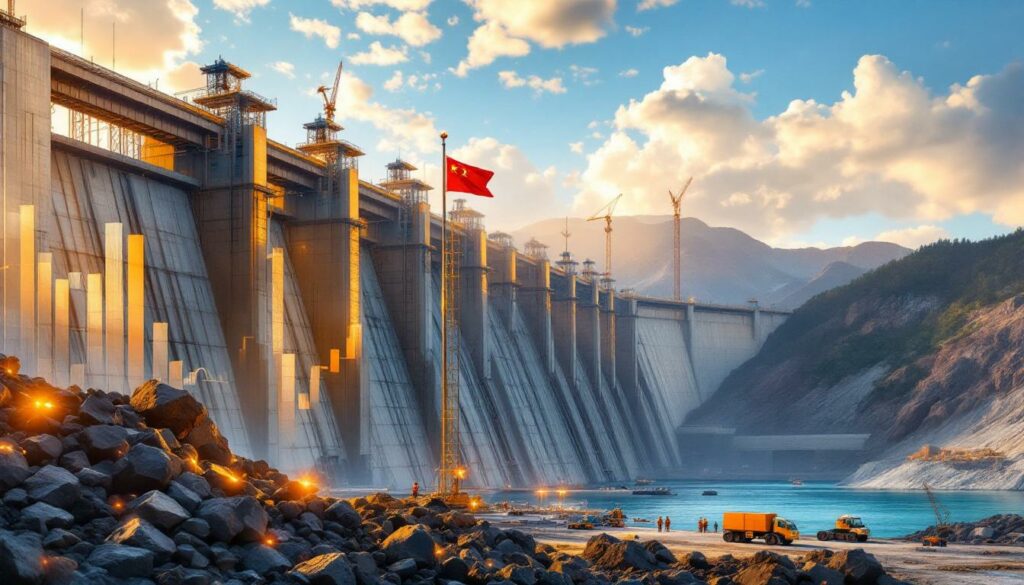Iron Ore Futures Hit Multi-Month Highs on China's Mega-Dam Announcement
The global commodities market witnessed a significant surge in iron ore futures following China's announcement of what will become the world's largest hydropower dam. This mega-infrastructure project has created ripples across steel and raw material markets, signaling potential long-term demand growth in the world's largest steel-producing nation.
Price Surge Details and Market Response
The September iron ore contract on China's Dalian Commodity Exchange jumped 2.08% to 809 yuan ($112.74) per metric ton on July 21, 2025, touching an impressive intraday high of 819 yuan—the highest level since February 26, 2025. Simultaneously, the benchmark August iron ore contract on the Singapore Exchange climbed 2.81% to $103.6 per ton, reaching an intraday peak of $104.8, marking its highest point since February 27.
"Iron ore and rebar futures markets are reacting positively to the announcement of the mega-dam project. There is little doubt that its construction will significantly benefit local steel markets," noted Atilla Widnell, Managing Director at Navigate Commodities in Singapore, in comments to Mining Weekly on July 21, 2025.
The market enthusiasm extended beyond iron ore to other steelmaking raw materials, with coking coal futures on the Dalian exchange surging 7.88% and coke futures rising 5.05% during the same trading session.
Key Price Movements at a Glance
| Contract | Exchange | Price Change | Peak Level | Previous High |
|---|---|---|---|---|
| September Iron Ore | Dalian Commodity Exchange | +2.08% to ¥809 | ¥819 | Highest since Feb 26 |
| August Iron Ore | Singapore Exchange | +2.81% to $103.6 | $104.8 | Highest since Feb 27 |
| Coking Coal | Dalian Commodity Exchange | +7.88% | – | – |
| Coke | Dalian Commodity Exchange | +5.05% | – | – |
What Makes China's New Mega-Dam Project Significant?
The newly announced hydropower project represents a landmark in renewable energy infrastructure with profound implications for construction materials markets, particularly steel. According to industry experts, this project aligns with China's dual strategy of enhancing renewable energy capacity while stimulating economic growth through infrastructure investment.
Unprecedented Scale and Material Requirements
The scope of the new mega-dam significantly exceeds China's previous large-scale hydropower projects. According to Atilla Widnell of Navigate Commodities, the project will require approximately "three to four times more construction materials than the Three Gorges Dam," highlighting the massive scale of steel consumption anticipated in the coming years.
For context, the Three Gorges Dam—currently the world's largest hydroelectric power station—required approximately 463,000 tonnes of steel during its construction. Following Widnell's estimation, the new mega-dam could require between 1.4 million and 1.8 million tonnes of steel, representing a substantial demand increase for China's steel industry.
Environmental and Economic Strategic Value
This project serves dual purposes in China's national strategy:
- Climate commitment advancement: Expanding renewable energy capacity to reduce reliance on coal-fired power
- Economic stimulus: Creating sustained demand for industrial materials and employment opportunities across multiple sectors
- Energy security enhancement: Reducing dependency on imported energy sources
Construction Material Demand Forecast
The construction phase will create sustained demand for various steel products:
- Reinforcement bars (rebar): Essential for concrete structures and foundations
- Structural steel: Required for dam walls, gates, and supporting infrastructure
- High-grade plate steel: Needed for hydroelectric turbines and specialized equipment
- Steel wire and mesh: Used for concrete reinforcement and erosion control
Industry Insight: "While the immediate focus is on steel demand, the project will also drive consumption of copper, aluminum, and specialty metals required for power generation equipment and transmission infrastructure," notes Mining Weekly's analysis of the announcement impact.
Why Are Steel Producers Responding Positively?
The announcement has triggered optimistic movements across China's steel sector, with producers ramping up operations in anticipation of increased demand. This positive reaction reflects confidence in the project's ability to absorb excess steel capacity that has plagued the industry in recent years.
Improved Steel Mill Margins and Capacity Utilization
According to industry data from Mysteel Global cited in the Mining Weekly report, steel mills have been expanding blast furnace operations, with the average capacity utilization rate rising by 0.99 percentage points week-on-week during July 11-17, 2025. This operational expansion suggests producers are positioning themselves to capitalize on anticipated demand growth.
The improved margins for steel producers come after several challenging quarters where overcapacity concerns and environmental restrictions had dampened profitability. The mega-dam announcement provides a renewed sense of optimism about sustainable demand.
Steel Product Price Movements
The positive sentiment has extended beyond raw materials to finished steel products traded on the Shanghai Futures Exchange:
| Steel Product | Price Change (July 21, 2025) |
|---|---|
| Rebar | +2.15% |
| Wire Rod | +2.48% |
| Hot-Rolled Coil | +2.2% |
| Stainless Steel | +1.33% |
This broad-based rally across the steel value chain indicates market confidence that the mega-dam project will drive significant materials consumption over an extended period.
What Other Factors Are Supporting Iron Ore Prices?
While the mega-dam announcement provided immediate momentum for iron ore futures, several underlying factors continue to support market strength beyond this single project.
China's Supportive Economic Policy Stance
China maintained its benchmark lending rates unchanged in its most recent announcement, aligning with market expectations following slightly better-than-expected second-quarter economic data for 2025. This stability in monetary policy has reassured markets about the government's commitment to supporting economic growth through the remainder of 2025 and beyond.
The People's Bank of China's decision to maintain rates rather than tighten monetary policy suggests continued support for infrastructure development and industrial activity, creating a favorable environment for steel demand.
Expectations of Additional Stimulus Measures
Market participants increasingly anticipate further macroeconomic policy stimulus from China's central government, potentially including:
- Infrastructure spending packages: Additional large-scale projects beyond the mega-dam
- Property sector support: Measures to stabilize the real estate market, a key steel consumer
- Manufacturing incentives: Programs to boost industrial output and modernization
- Green energy transition funding: Accelerated investments in renewable energy infrastructure
These expectations have contributed to the positive price momentum for iron ore price trends and steel products, as traders position for potential demand increases beyond the announced dam project.
Favorable Supply-Demand Dynamics
The combination of potentially increasing Chinese demand and relatively constrained global iron ore supply continues to underpin price strength. Major producers have maintained disciplined expansion plans, avoiding the oversupply conditions that depressed markets in previous cycles.
Market Perspective: "The supply side remains relatively tight with major producers focused on value over volume. Combined with China's renewed infrastructure push, this creates a supportive environment for sustained price strength," according to the Mining Weekly analysis.
How Might This Affect Global Iron Ore Markets?
The construction of China's mega-dam project could have lasting implications for global iron ore markets and producers, potentially reshaping trade flows and investment priorities.
Potential Winners Among Iron Ore Producers
Major iron ore suppliers with significant exposure to the Chinese market stand to benefit from sustained higher prices and increased import volumes:
- Australian producers (BHP, Rio Tinto, Fortescue): Their geographical proximity and established export channels to China position them favorably to meet increased demand.
- Brazilian miners (Vale): Despite longer shipping distances, their high-grade ore is particularly suitable for efficient steel production and could command premium prices.
- Emerging producers: Junior miners with development-stage projects may find improved economics and financing conditions to bring new capacity online during the construction period.
Shipping and Logistics Implications
The increased iron ore demand will likely tighten the seaborne market, benefiting dry bulk shipping companies specializing in large cargo vessels. Routes from Australia and Brazil to China could see increased vessel demand and freight rates, particularly for Capesize vessels that typically transport iron ore.
Price Outlook and Volatility Considerations
While the immediate market reaction has been positive, investors should consider several factors that could influence price volatility over the multi-year construction timeline:
- Seasonal variations: Construction activity in China typically slows during winter months and rainy seasons
- Policy implementation timing: The actual pace of dam construction may differ from market expectations
- Environmental regulations: Potential restrictions on steel production in key regions to meet emissions targets
- Global economic conditions: Broader economic factors affecting overall steel demand beyond the dam project
What Should Investors Watch Going Forward?
For those monitoring iron ore and steel markets, several key indicators will provide insights into the sustainability of the current price rally and long-term market direction.
Critical Market Indicators to Monitor
-
Chinese steel production rates: Monthly production figures from China's National Bureau of Statistics will signal whether mills are maintaining higher output levels in response to anticipated demand.
-
Port inventory levels: Declining iron ore stockpiles at Chinese ports would indicate robust consumption and potential supply tightness. Mysteel Global's weekly inventory reports provide this critical data.
-
Policy announcements: Investors should watch for additional infrastructure projects or stimulus measures from China's National Development and Reform Commission that could further boost steel demand.
-
Steel mill profitability: Sustained margins support continued strong iron ore demand. The steel mill profitability index from industry sources like Mysteel provides visibility into this trend.
Potential Risks to Consider
Despite the positive outlook, several factors could temper price momentum:
- Environmental restrictions: China's dual carbon goals may lead to production caps in high-emission steel regions like Hebei and Tangshan.
- Economic growth concerns: Any significant slowdown in broader Chinese economic activity could offset dam-related demand.
- Supply increases: Major iron ore producers might accelerate expansion plans in response to higher prices, potentially creating future iron ore surplus analysis.
- Geopolitical tensions: Trade relations between China and key supplier nations could impact iron ore flows and pricing.
Investment Disclaimer: Commodity markets are inherently volatile and subject to rapid changes based on multiple factors. Investors should conduct thorough research and consider professional financial advice before making investment decisions based on infrastructure project announcements.
FAQ: Iron Ore Market Implications
How long will the mega-dam construction impact iron ore demand?
Based on previous large-scale hydropower projects in China, construction is likely to span 5-10 years. The most intensive steel consumption typically occurs during the first 3-5 years when foundation work and major structural elements are built. This suggests a multi-year positive impact on construction material demand, with gradually diminishing requirements in later project phases.
Will this project affect global iron ore shipping patterns?
The increased iron ore requirements will likely tighten the seaborne market, potentially benefiting major shipping companies specializing in dry bulk transport. Routes from Australia and Brazil to China could see increased vessel demand and freight rates as more cargo moves to meet construction needs. This may also accelerate the trend toward larger, more efficient vessels to optimize shipping costs.
How does this project compare to other infrastructure initiatives in China?
The mega-dam represents one of China's most significant single infrastructure projects in recent years, surpassing most individual Belt and Road Initiative projects in terms of material requirements and investment scale. Unlike the more geographically dispersed BRI projects, this concentrated development creates a sustained demand center that may be easier for steel producers and iron ore demand insights to service efficiently.
Could environmental regulations limit the steel production increase?
While China maintains environmental targets that restrict steel production in some regions, projects designated as national priorities often receive exemptions or accommodations within the regulatory framework. The renewable energy benefits of the dam project align with China's climate goals, potentially providing justification for temporary increases in steel production to support its construction.
What technological factors might influence steel requirements for the project?
Modern dam construction techniques have evolved since earlier projects like Three Gorges. Advanced high-strength steel alloys may allow for more efficient material use, potentially reducing the total tonnage required. Conversely, the extreme scale of the project and challenging geological conditions could necessitate more robust structural elements, increasing steel intensity beyond simple scaling from previous projects. Recent iron ore forecast insights suggest mining companies are already preparing for this increased demand, with BHP's strategic pivot showing how major producers are repositioning themselves.
Ready to Capitalise on the Next ASX Mining Discovery?
Discover potentially transformative mining opportunities before the market with Discovery Alert's proprietary Discovery IQ model, which instantly analyses ASX announcements to deliver real-time alerts on significant mineral discoveries. Visit the Discovery Alert discoveries page to see how major mineral discoveries have historically generated substantial returns for early investors.




